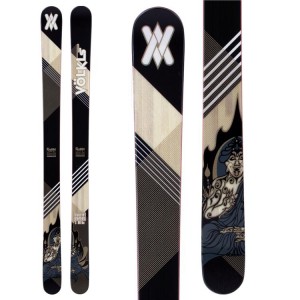By Art Bentley
After years of skepticism about the claims of manufacturers promoting wide skis shaped like the defining parts of a rocking chair, I’ve come around. The rocker design rocks.
 What convinced me was a day on the Volkl Gotama, a portly plank 130 millimeters wide at the tip, 123 at the tail, and 107 underfoot.
What convinced me was a day on the Volkl Gotama, a portly plank 130 millimeters wide at the tip, 123 at the tail, and 107 underfoot.
Recently, I took a pair all over Bald Mountain, the legendary hill, better known as Baldy, that has been attracting folks to Sun Valley, Idaho, since late 1939, shortly after Ernest Hemingway finished writing “For Whom the Bell Tolls” in room 206 at the Sun Valley Lodge.
At first I was a trifle leery. This is a beefy board, and I was on the 178-centimeter version, 18 centimeters longer than the slalom skis I usually use.
However, Brad Woods in the ski shop at River Run assured me that due to the rocker design, the length would not be a drawback because the points at which the ski touches the snow are much closer to the boot heel and toe than on a cambered ski with its slight upward arch. Consequently, rocker skis can be tipped on edge much more quickly and easily.
Because I didn’t know what to expect from the Gotamas, I enrolled in College, the easiest run on Baldy, denoted by the green circle that usually marks terrain barely steep enough to induce motion. At Sun Valley, however, it’s not so easy skiing green. College tilts 19 degrees, which would easily rate the blue square of an intermediate run at many resorts.
I angled down the slope from the top. The snow was firm and fast, not supposedly the most favorable condition for full-rocker skis, whose element is deep, untracked powder. I gained speed quickly, easy on Baldy, which has no flat spots. I weighted the downhill edge of the uphill ski, and instantly the Volkls snapped around in a quick, tight and surprisingly effortless C-shaped arc that reminded me of another German name: Porsche.
I repeated the procedure, the result was the same, and my confidence soared. I let the skis go and started leaning into the turns as hard as I could. The Gotamas continued to perform with the same solid authority that makes this sport so addictive.
Five inches of snow had fallen the day before, covering a surface that remained solidly frozen where the groomers hadn’t ventured. Can-Can, a blue run of about 25 degrees, was bumpy and icy under the fresh snow. The skis couldn’t have cared less. As long as I was positioned properly, they turned with the same sport-car precision.
Next I tried Flying Squirrel, a blue run groomed nightly. Here I noticed another trait of the full-rocker design. Whenever I wanted to slow the skis, all I had to do was press with my downhill heel, directing force to the tails. Immediately, the brakes were applied.
Later, I sampled untracked snow in one of Baldy’s eight bowls. Although the skis were scraping a gelid surface under the powder, I got a sense of how they perform in bottomless snow.
